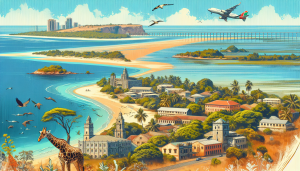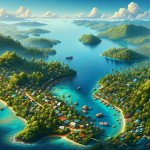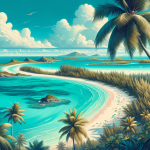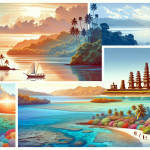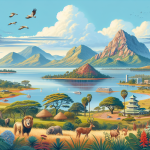Mozambique: A Hidden Gem in Southeast Africa
Mozambique, a coastal nation in Southeast Africa, is often overlooked by travelers in favor of its more famous neighbors. However, this hidden gem offers a wealth of experiences for those willing to venture off the beaten path. From pristine beaches and turquoise waters to vibrant cultures and rich history, Mozambique is a destination that promises unforgettable memories. This article will delve into the wonders of Mozambique, offering insights into its top attractions, cultural richness, and practical travel tips to help you plan your next adventure. Whether you’re a beach lover, history buff, or adventure seeker, Mozambique has something to offer for everyone. So, let’s embark on a journey to explore the magic of Mozambique and uncover why it should be on your travel radar.
Breathtaking Beaches and Islands
The Quirimbas Archipelago
The Quirimbas Archipelago, located in the northern part of Mozambique, is a chain of 32 islands stretching along the coast. These islands are famous for their pristine beaches, crystal-clear waters, and rich marine life. The Quirimbas National Park, which covers a significant portion of the archipelago, is a UNESCO World Heritage site. Here, you can indulge in activities such as snorkeling, scuba diving, and kayaking while exploring the vibrant coral reefs and diverse marine species.
Bazaruto Archipelago
Another must-visit destination is the Bazaruto Archipelago, situated off the southern coast. This group of six islands is renowned for its white sandy beaches, towering sand dunes, and clear turquoise waters. The Bazaruto Marine National Park, which encompasses the archipelago, offers excellent opportunities for diving and snorkeling, with sightings of dugongs, dolphins, and a variety of colorful fish. For those seeking luxury, the islands also host some of Mozambique’s most exclusive resorts.
Rich Cultural Heritage
Maputo: The Capital City
Maputo, the vibrant capital of Mozambique, is a city that exudes culture and history. Known for its Portuguese colonial architecture, bustling markets, and lively arts scene, Maputo offers a fascinating glimpse into the country’s past and present. Visit the Central Market to experience the local flavors, or take a stroll through the city’s streets to admire the beautiful buildings such as the Iron House and the Maputo Railway Station, designed by Gustave Eiffel.
Ilha de Moçambique
Ilha de Moçambique, a small coral island located in the northern part of the country, is a UNESCO World Heritage site and a treasure trove of history. Once the capital of colonial Portuguese East Africa, the island is home to some of the oldest colonial buildings in the Southern Hemisphere. The island’s Stone Town features a mix of Portuguese, Arab, and Indian influences, with narrow streets, historic churches, and ancient mosques. Visiting Ilha de Moçambique is like stepping back in time, offering a unique cultural experience.
Adventure and Wildlife
Gorongosa National Park
For wildlife enthusiasts, Gorongosa National Park is a must-visit destination. Located in central Mozambique, the park is renowned for its biodiversity and conservation efforts. Gorongosa is home to a variety of wildlife, including elephants, lions, hippos, and a plethora of bird species. The park also offers guided safaris, hiking trails, and cultural tours, providing an immersive experience in the heart of nature.
Diving and Snorkeling
Mozambique’s coastline is a paradise for divers and snorkelers. The country’s extensive coral reefs and marine reserves offer some of the best underwater experiences in the world. Sites such as Tofo Beach, Ponta do Ouro, and Inhaca Island boast vibrant coral gardens, underwater caves, and an abundance of marine life, including whale sharks, manta rays, and humpback whales. Whether you’re a seasoned diver or a beginner, Mozambique’s waters promise an unforgettable underwater adventure.
Practical Travel Tips
Best Time to Visit
The best time to visit Mozambique depends on your preferred activities. For beach holidays and water sports, the dry season from May to November is ideal, with warm temperatures and minimal rainfall. Wildlife enthusiasts should consider visiting during the cooler months of June to October, when animals are more active and easier to spot. The rainy season, from December to April, can bring heavy showers and cyclones, but it also offers lush landscapes and fewer tourists.
Visa Requirements
Before traveling to Mozambique, check the visa requirements for your nationality. Most travelers will need a visa, which can be obtained from Mozambican embassies or consulates. Some nationalities may be eligible for a visa on arrival, but it’s advisable to confirm this before departure. Ensure your passport is valid for at least six months beyond your planned departure date.
Health and Safety
When traveling to Mozambique, it’s important to take health precautions. Malaria is prevalent in the country, so consult your doctor about anti-malarial medication and take measures to prevent mosquito bites. It’s also recommended to have vaccinations for diseases such as hepatitis A, typhoid, and yellow fever. In terms of safety, Mozambique is generally safe for tourists, but it’s wise to stay informed about the local situation and avoid traveling to areas with political unrest or high crime rates.
Culinary Delights
Fresh Seafood
Mozambique’s coastal location means that seafood is a staple of the local cuisine. From grilled prawns to spicy crab curries, the country’s seafood dishes are a must-try for any visitor. The prawns, often marinated in peri-peri sauce, are particularly famous and can be found in many restaurants and markets across the country.
Matapa and Piri Piri Chicken
Matapa, a traditional dish made from cassava leaves cooked with peanuts, garlic, and coconut milk, is another highlight of Mozambican cuisine. This flavorful dish is often served with rice or xima (a type of maize porridge). For those who enjoy spicy food, Piri Piri Chicken is a must-try. This dish, made with chicken marinated in a fiery peri-peri sauce, showcases the country’s love for bold and spicy flavors.
Sustainable Travel
Supporting Local Communities
When traveling to Mozambique, consider ways to support local communities and promote sustainable tourism. Choose locally-owned accommodations and restaurants, purchase handmade crafts from local artisans, and participate in community-based tourism initiatives. By doing so, you contribute to the local economy and help preserve Mozambique’s cultural and natural heritage.
Eco-friendly Practices
Mozambique’s natural beauty is one of its greatest assets, and it’s important to protect it for future generations. Practice eco-friendly behaviors such as reducing plastic use, conserving water and energy, and respecting wildlife and natural habitats. Many lodges and resorts in Mozambique are committed to sustainability, so look for eco-friendly accommodations that prioritize environmental conservation.
Conclusion
Mozambique is a destination that offers a unique blend of natural beauty, rich cultural heritage, and exciting adventures. From the idyllic beaches of the Quirimbas and Bazaruto Archipelagos to the historic streets of Maputo and Ilha de Moçambique, there’s something for every traveler to enjoy. Whether you’re diving into the vibrant coral reefs, exploring ancient colonial buildings, or savoring the delicious local cuisine, Mozambique promises an unforgettable travel experience. By embracing sustainable travel practices and supporting local communities, you can help preserve this incredible destination for future generations. So pack your bags and get ready to discover the magic of Mozambique, a hidden gem waiting to be explored.
For more information on planning your trip to Mozambique, visit Lonely Planet.
